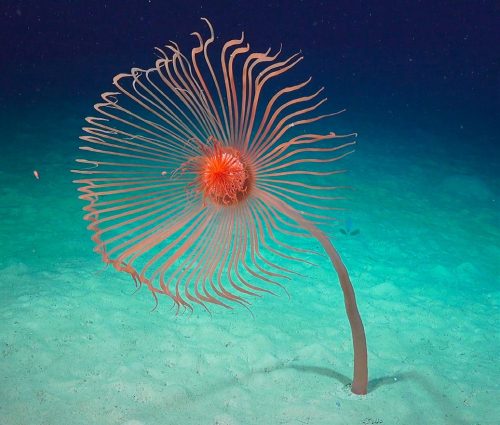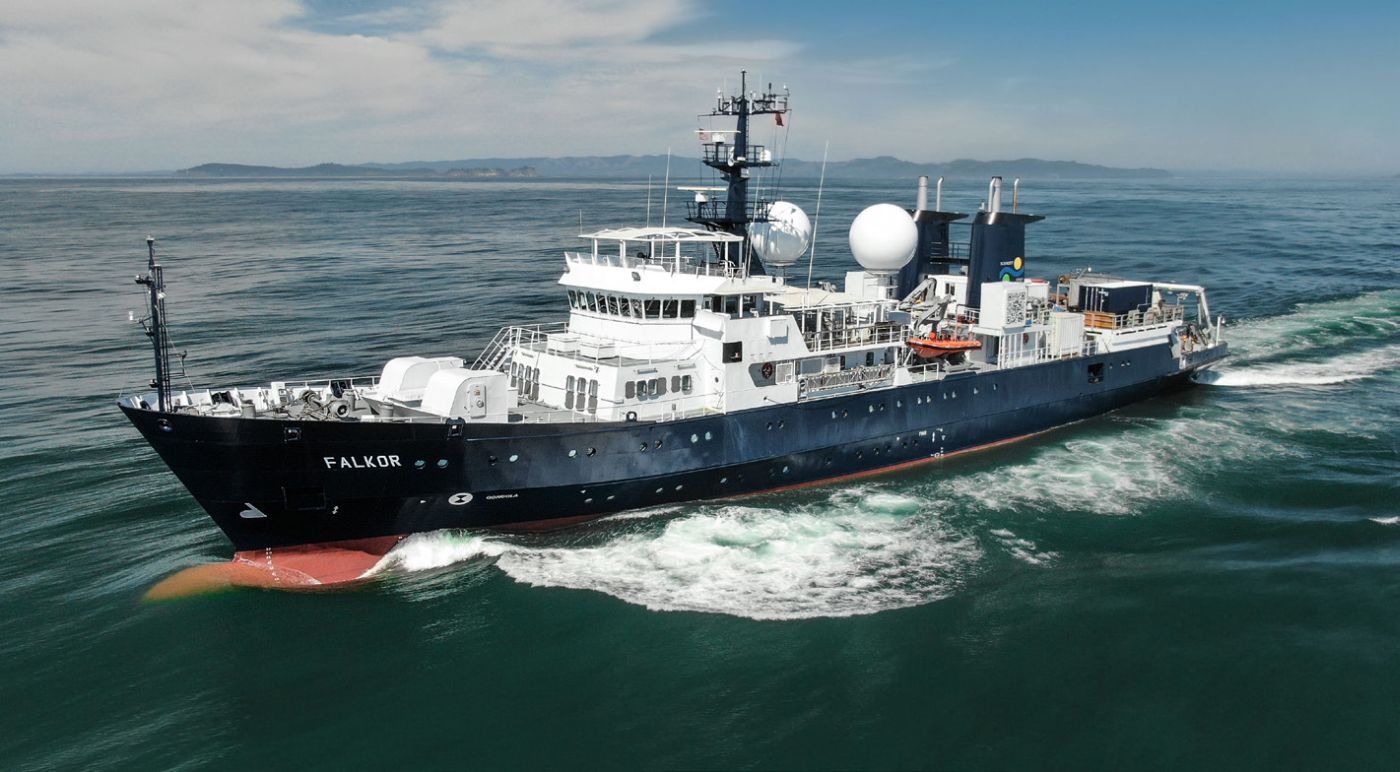New knowledge from new technology
Jyotika Virmani and Carlie Wiener of the Schmidt Ocean Institute outline some of the important discoveries being made in the deep sea
Alien landscapes and a mind-boggling variety of life await us in one of the most fascinating places on our planet, the ocean. It is also a place of infinite mystery – we still don’t know what 95 per cent of it, by volume, contains. Recent technological advances have brought deep-sea exploration into its teenage years, yet it still presents challenges due to its scale and dark, cold, corrosive and high-pressure environments. Since 2009, the Schmidt Ocean Institute, founded by Eric and Wendy Schmidt, has been spearheading a philanthropic model to spur scientific discovery and exploration of this hard-to-reach world through the judicious use of sophisticated technology, cutting-edge research and open access to data. These efforts are illuminating the wonders that lie beneath the surface and are providing the information needed to understand this dynamic and vital ecosystem.
Through its 76-metre research vessel Falkor, complete with on-board laboratories, a state-of-the-art 4,500-metre-capable underwater robotic system, ROV SuBastian, and high performance computing facilities, the Schmidt Ocean Institute provides a high-tech platform for scientists and innovators around the world. These assets are made available at no cost, to promote collaboration and exploration, and to aid marine research and technology development. The findings are shared openly and made public in the recognition that freely available data speeds up additional research and innovation.
Technology is helping us find life in the ocean in forms, at depths and in habitats we could barely have imagined. Underwater discoveries of new species and strange deep-sea landscapes are shared with the public through live broadcasts, using 4K cameras mounted on the ROV, to a global audience via social media. The findings are depicted in novel ways, such as the Institute’s Artist-at-Sea programme, where artists depict the research through their work, which is showcased in travelling exhibitions. The collection currently contains more than 135 pieces. These oceanographic expeditions have led to numerous discoveries of new species, geological features and interesting phenomena in the deep sea, and data that has supported the preservation of areas of particular interest.
Going deep down under

RV Falkor recently journeyed to Australia on a year-long initiative, giving scientists an unprecedented opportunity to explore deepsea canyons and coral reefs that have never been seen before. The data collected in the three oceans that surround Australia, which include submarine canyons and the world’s largest barrier reef, has important implications for the sustainability and protection of these underwater ecosystems – and for similar habitats worldwide that are poorly understood and under threat.
The first expedition of the year took RV Falkor to south-eastern Australia and the Bremer Canyon, providing critical information on the recent and past histories of climate change and ocean conditions in this region, as well as on global-scale events. That particular canyon, facing the Southern Ocean, provides insights into the global climate engine, as the waters invading the canyon also encircle Antarctica, and thus regulate the supply of heat and nutrient-rich waters to all major oceans.
The shallower regions of Bremer Canyon Marine Park are known as a biodiversity hotspot for marine species such as whales and dolphins. However, this expedition, with scientists from the University of Western Australia, the Institute of Polar Sciences (Italy), and the Western Australian Museum, revealed rich and diverse ecosystems in the deeper reaches of the canyon, in cold waters that originate from Antarctica. Previously unknown vertical cliffs and ridges showcased numerous deep-sea corals that formed their own mini-ecosystems. Such rare records of these deep-sea habitats have provided new insights that will help managers of the marine park, as well as the broader community, to better understand and protect these previously unknown ecosystems and gather baseline data to monitor climate change.
Off north-western Australia, the canyons near Ningaloo also yielded amazing biological discoveries. Over the course of 20 ROV dives, as many as 30 new marine species were found. The science team, from the Western Australian Museum, Curtin University, Geoscience Australia, and Scripps Institution of Oceanography (US), made history by collecting the first giant hydroids seen in Australia, discovering large communities of glass sponges in Cape Range Canyon, and observing for the first time in Western Australia the bioluminescent Taning’s octopus squid, the long-tailed sea cucumber and a number of molluscs and crustaceans, including barnacle and squat lobster species. The Indian Ocean deep-water samples will also be screened for environmental DNA to reveal the presence of creatures that swim in these waters but were not seen during the dives. The scientific and educational benefits of this expedition will continue long after the on-site sampling.
A discovery of epic proportions

During this expedition, the scientists stood astonished when the world’s longest sea creature – a truly stunning 150-foot siphonophore – was discovered at over 600 metres depth. This long, string-like floating colony of tiny, individual, cloned zooids that act as a single creature was just one of the secrets found in the ocean’s depths. Vast and unexplored as the ocean is, these expeditions continue to show us how massive and strange this planet actually is, and how little we know.
Science and Covid-19
Despite the global pandemic, technology permitted Schmidt Ocean Institute to continue with its field operations and to connect expedition scientists from James Cook University, Geosciences Australia and the University of Sydney with the crew and ROV operators on board RV Falkor – one of the very few at-sea expeditions to continue operating. Pairing the underwater robot with the ship and layering on sophisticated communications allowed researchers, including some who were not formally part of the expedition, and a broader public audience, to participate remotely from their homes during a time when travel and additional personnel on the vessel were not permitted. Video footage from the deeper waters in the Coral Sea off north-eastern Australia marked the first time that humans had peered into the depths of one of the largest marine parks in the world. The live-streamed dives created an online platform, drawing spectators from around the world to witness such elusive species as deep-water sharks and the chambered nautilus – a distant cousin of squids, which uses jet propulsion to move. The team discovered the deepest living hard corals in eastern Australian waters, sighted fish that had previously only been seen in Hawaiian waters, and identified up to 10 potentially new marine species of fish, snails and sponges.
Mapping the seafloor

During the year-long effort to date, the team aboard RV Falkor has mapped more than 95,690 sq. km of seafloor at high resolution, transforming some of the poorest-mapped regions into the best-mapped frontier areas of Australia’s marine estate. For example, the maps illuminated a complex seafloor on the Queensland plateau, showcasing 30 large coral atolls and banks, and a better understanding of the physical and long-term geological changes that have occurred on the deep reefs. The maps are also publicly available through AusSeabed, a national Australian seabed mapping programme, and through the Nippon Foundation’s GEBCO Seabed 2030 Project. To date, the Schmidt Ocean Institute has contributed over 1.2 million sq. km of high resolution global bathymetry data to the Seabed 2030 Project. Building on the mapping that has been done, remotely operated and autonomous technologies will help Seabed 2030 produce a high-resolution map of the entire seafloor by 2030 – and, most importantly, will scale up our ability to conduct the science and research we need to make our ocean healthy and manage this natural wonder.
Marine Protected Areas around the world are vital to the protection of slow-growing deep-sea species and the systems they inhabit. In a year that has hampered fieldwork, Schmidt Ocean Institute’s Australian expeditions have revealed the diversity of life and provided insights into the interconnectedness of the earth’s system, from the atmosphere to deep-sea canyons. Over the last few years of operations, the data gathered by the RV Falkor expeditions has contributed to the long-term monitoring and management of several other marine protected areas, including the Papahānaumokuākea Marine National Monument (Hawaii), the Phoenix Islands Protected Area, the Marianas Trench Marine Protected Area, the Pacific Remote Islands Marine National Monument and the Cocos Island Marine Reserve.
As only 5 per cent of coastal nations operate multiple research vessels, approximately 95 per cent of coastal nations have little ability to explore their own deep waters. This is problematic, not only for individual nations that need to understand and manage their own resources, but also for general comprehension of global deep-sea connectivity. Advances in technology will allow greater access to the ocean, giving more people the ability to explore the hidden worlds beyond the coastline and to maximise the chances of achieving a healthy ocean.
Dr Jyotika I Virmani, PhD is Executive Director of the Schmidt Ocean Institute; Dr Carlie Wiener, PhD, is the Institute’s Director of Communications and Engagement Strategy
